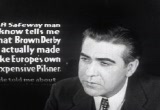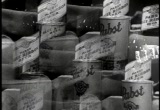This week I attended a showing of beer-related films at the Hearst Museum of Anthropology at Cal. Research anthropologist Ira Jaknis, curator of the ongoing exhibit 99 Bottles of Beer: Global Brewing Traditions 2500 B.C. — Present was our host for the films. Sadly, only three other people were attendance. But, because the Prelinger Archives are 99.9% awesomesauce, you can watch them, too.
The original event title was “Two Short Films About Traditional Beers”, but Ira wasn’t able to obtain the copy of “Caxiri or Manioc Beer” that is at the Moffitt Library on campus. That short was filmed of the Waiãpi Indians of Brazil by Victor Fuks in 1988. I was bit bummed, because I had tried to brew manioc beer last week. I got no fermentation action, so I was hoping to pick up some video tips on proper chewing and spitting of the manioc. It appears one key step is to mix in a bit of still fermenting brew from the previous batch, which is a bit problematic for me.
 However, we did get to see the fascinating “Brewing Millet Beer in Africa” by Christopher D. Roy (2006). You can watch a trailer for the film via a link on that page. However, the trailer gives you only a hint of how interesting and well-composed the film is. The opening shot of the women grinding the millet is pretty great, though. The film was shot in Burkina Faso.
However, we did get to see the fascinating “Brewing Millet Beer in Africa” by Christopher D. Roy (2006). You can watch a trailer for the film via a link on that page. However, the trailer gives you only a hint of how interesting and well-composed the film is. The opening shot of the women grinding the millet is pretty great, though. The film was shot in Burkina Faso.
As in a few other cultures, the women brew and sell the beer. Apparently, some of the more successful African women are able to develop a relatively large scale business and purchase trucks to ship the beer outside of their village.
In the film we get to watch and listen to Zenabu Bamogo as she sprouts the millet, dries it, grinds it, boils it, filters out the wort (albeit with only a woven basket), ferments it overnight, cleans clay pots, pours out the beer and sells it. It’s fun to listen to her as she probably sees the action of the yeast at night for the very first time, since she wouldn’t normally have access to a bright flashlight. I’m not sure exactly which language she is speaking, but you can hear a man translating in French in the background. The film is subtitled in English.
In place of “Caxiri or Manioc Beer”, Ira showed us 4 of the 6 shorts on a DVD he personally owns. I believed the DVD was named something like Historic Beer Film in America. Anyway, that describes the content pretty well.
 First, we watched “For Good Living“, a hysterically poorly produced silent film from 1937 made as a promo by Safeway for their Brown Derby beer, which they declared to be “Imported’s Equal”. The West Coast Grocery company actually contracted with Humboldt Malt and Brewing Company in Eureka, California, and later many other breweries, to produce this pilsner-style beer with “the genuine Pilsner tang!” West Coast Grocery distributed the beer to Safeway and at least one other grocer, though it later became solely Safeway’s house brand. According to rustycans.com (an awesomely informative website), the Brown Derby restaurant in LA sued them for copyright infringement and forced them to redesign the label.
First, we watched “For Good Living“, a hysterically poorly produced silent film from 1937 made as a promo by Safeway for their Brown Derby beer, which they declared to be “Imported’s Equal”. The West Coast Grocery company actually contracted with Humboldt Malt and Brewing Company in Eureka, California, and later many other breweries, to produce this pilsner-style beer with “the genuine Pilsner tang!” West Coast Grocery distributed the beer to Safeway and at least one other grocer, though it later became solely Safeway’s house brand. According to rustycans.com (an awesomely informative website), the Brown Derby restaurant in LA sued them for copyright infringement and forced them to redesign the label.
The captions are scrolled into view at times by someone lowering a black piece of paper at glacial places, and other times by turning a large roller on which they are printed. The scene about 3.5 minutes in of entering the Office of the Brewmaster feels like a scene from Psycho. Any second, I was expecting to see him tossed head first into a lauter tun.
We also get to see malt that is “finely ground and cleaned” before apparently being quality checked by being sifted through by hand by a guy in suspenders with greasy fingers. There is more quality checking on the assembly line, which appears to consist of removing every 10th bottle.
Thanks to the Prelinger Archives, you can watch all 19 wacky minutes of “For Good Living“.
After the film ended, I commented to Ira that film editing was apparently not invented until after 1937.
 This was in sharp contrast with “Help Yourself” by Pabst, which reminded me of the old newsreels that were popular in theaters back in the 1940’s and 50’s (not that I was around to know). More than a little heavy-handed, this film attempts to browbeat and guilt trip distributors into putting all their efforts into getting retailers to sell more Pabst beer.
This was in sharp contrast with “Help Yourself” by Pabst, which reminded me of the old newsreels that were popular in theaters back in the 1940’s and 50’s (not that I was around to know). More than a little heavy-handed, this film attempts to browbeat and guilt trip distributors into putting all their efforts into getting retailers to sell more Pabst beer.
While the first film muddles up the picture of the three-tier system (the US system where breweries sell to distributors who sell to retailers who sell to customers), the Pabst promo film makes the picture clearer. The third film mentioned below lobbies hard for the three-tier system.
 Next up was “As We Like It“, a not even remotely Shakespearian tale produced on behalf of the United States Brewers Foundation. Starting off with the ancient history of beer and quickly moving through the pilgrims up to the modern science of food, we get a full on lobbying press for the status quo. And did we mention brewers pay lots of taxes?
Next up was “As We Like It“, a not even remotely Shakespearian tale produced on behalf of the United States Brewers Foundation. Starting off with the ancient history of beer and quickly moving through the pilgrims up to the modern science of food, we get a full on lobbying press for the status quo. And did we mention brewers pay lots of taxes?
As shown in the mirror of our friendly bartender, the five principles that will keep the prohibitionist bogey man away are:
- Quality of product
- Cleanliness
- Friendliness
- Observance of the law
- Good citizenship
You can watch this video at the Internet Archive, or on the Beer In Food blog/YouTube.
There was also a 20-second Labatts commercial that was only slightly creepy.
Pingback: Friday Brain Candy: Jerry Seinfeld, Martin Sorrell, and Hearst’s App Ambitions | Media Broker Pro